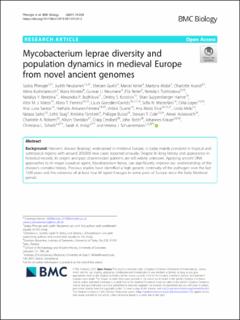Mycobacterium leprae diversity and population dynamics in medieval Europe from novel ancient genomes
| dc.contributor.author | Pfrengle, Saskia | |
| dc.contributor.author | Neukamm, Judith | |
| dc.contributor.author | Guellil, Meriam | |
| dc.contributor.author | Keller, Marcel | |
| dc.contributor.author | Molak, Martyna | |
| dc.contributor.author | Avanzi, Charlotte | |
| dc.contributor.author | Kushniarevich, Alena | |
| dc.contributor.author | Montes, Núria | |
| dc.contributor.author | Neumann, Gunnar U. | |
| dc.contributor.author | Reiter, Ella | |
| dc.contributor.author | Tukhbatova, Rezeda I. | |
| dc.contributor.author | Berezina, Nataliya Y. | |
| dc.contributor.author | Buzhilova, Alexandra | |
| dc.contributor.author | Korobov, Dmitry S. | |
| dc.contributor.author | Suppersberger Hamre, Stian | |
| dc.contributor.author | Matos, Vitor M. J. | |
| dc.contributor.author | Ferreira, Maria T. | |
| dc.contributor.author | González-Garrido, Laura | |
| dc.contributor.author | Wasterlain, Sofia N. | |
| dc.contributor.author | Lopes, Célia | |
| dc.contributor.author | Santos, Ana Luisa | |
| dc.contributor.author | Antunes-Ferreira, Nathalie | |
| dc.contributor.author | Duarte, Vitória | |
| dc.contributor.author | Silva, Ana Maria | |
| dc.contributor.author | Melo, Linda | |
| dc.contributor.author | Sarkic, Natasa | |
| dc.contributor.author | Saag, Lehti | |
| dc.contributor.author | Tambets, Kristiina | |
| dc.contributor.author | Busso, Philippe | |
| dc.contributor.author | Cole, Stewart T. | |
| dc.contributor.author | Avlasovich, Alexei | |
| dc.contributor.author | Roberts, Charlotte A. | |
| dc.contributor.author | Sheridan, Alison | |
| dc.contributor.author | Cessford, Craig | |
| dc.contributor.author | Robb, John | |
| dc.contributor.author | Krause, Johannes | |
| dc.contributor.author | Scheib, Christiana L. | |
| dc.contributor.author | Inskip, Sarah A. | |
| dc.contributor.author | Schuenemann, Verena J. | |
| dc.date.accessioned | 2022-03-08T11:56:21Z | |
| dc.date.available | 2022-03-08T11:56:21Z | |
| dc.date.created | 2022-02-07T08:58:03Z | |
| dc.date.issued | 2021 | |
| dc.identifier.issn | 1741-7007 | |
| dc.identifier.uri | https://hdl.handle.net/11250/2983770 | |
| dc.description.abstract | Background Hansen’s disease (leprosy), widespread in medieval Europe, is today mainly prevalent in tropical and subtropical regions with around 200,000 new cases reported annually. Despite its long history and appearance in historical records, its origins and past dissemination patterns are still widely unknown. Applying ancient DNA approaches to its major causative agent, Mycobacterium leprae, can significantly improve our understanding of the disease’s complex history. Previous studies have identified a high genetic continuity of the pathogen over the last 1500 years and the existence of at least four M. leprae lineages in some parts of Europe since the Early Medieval period. Results Here, we reconstructed 19 ancient M. leprae genomes to further investigate M. leprae’s genetic variation in Europe, with a dedicated focus on bacterial genomes from previously unstudied regions (Belarus, Iberia, Russia, Scotland), from multiple sites in a single region (Cambridgeshire, England), and from two Iberian leprosaria. Overall, our data confirm the existence of similar phylogeographic patterns across Europe, including high diversity in leprosaria. Further, we identified a new genotype in Belarus. By doubling the number of complete ancient M. leprae genomes, our results improve our knowledge of the past phylogeography of M. leprae and reveal a particularly high M. leprae diversity in European medieval leprosaria. Conclusions Our findings allow us to detect similar patterns of strain diversity across Europe with branch 3 as the most common branch and the leprosaria as centers for high diversity. The higher resolution of our phylogeny tree also refined our understanding of the interspecies transfer between red squirrels and humans pointing to a late antique/early medieval transmission. Furthermore, with our new estimates on the past population diversity of M. leprae, we gained first insights into the disease’s global history in relation to major historic events such as the Roman expansion or the beginning of the regular transatlantic long distance trade. In summary, our findings highlight how studying ancient M. leprae genomes worldwide improves our understanding of leprosy’s global history and can contribute to current models of M. leprae’s worldwide dissemination, including interspecies transmissions. | en_US |
| dc.language.iso | eng | en_US |
| dc.publisher | BMC | en_US |
| dc.rights | Navngivelse 4.0 Internasjonal | * |
| dc.rights.uri | http://creativecommons.org/licenses/by/4.0/deed.no | * |
| dc.title | Mycobacterium leprae diversity and population dynamics in medieval Europe from novel ancient genomes | en_US |
| dc.type | Journal article | en_US |
| dc.type | Peer reviewed | en_US |
| dc.description.version | publishedVersion | en_US |
| dc.rights.holder | Copyright The Author(s), 2021 | en_US |
| dc.source.articlenumber | 220 | en_US |
| cristin.ispublished | true | |
| cristin.fulltext | original | |
| cristin.qualitycode | 2 | |
| dc.identifier.doi | 10.1186/s12915-021-01120-2 | |
| dc.identifier.cristin | 1998345 | |
| dc.source.journal | BMC Biology | en_US |
| dc.identifier.citation | BMC Biology. 2021, 19, 220. | en_US |
| dc.source.volume | 19 | en_US |

